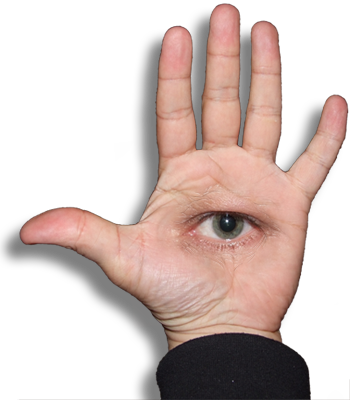This is a fragment of a textile design I did a few years ago, that I found again while reorganising our Junk Room. It's printed on calico, using an acetate stencil and a foam roller, with standard acrylic textile inks.
There's nothing terribly exciting about this bit of material except for the way it was printed. Stencilling with a roller is surprisingly quick and easy, and because the acetate is transparent, you can achieve very high accuracy in registration quite easily (though that wasn't really important for this piece).
The inks are mixed exactly as they would be for screen printing. You can buy them pre-mixed, if you don't have access to colour concentrates and heat-set acrylic base.
This piece, to the right, is another done the same way — it's designed for use as a game mat, stencilled with 25mm (1") hexes in two colours, with a larger hex overlay drawn over top. I was able to register each colour against the other very simply and accurately because I could see through the stencil.
I created the hex-layout in CorelDraw (any vector-illustration app should do the trick) and printed it on acetate designed for laser-printing. This gave me a high degree of accuracy very easily. Then I just had to cut it out with a scalpel.
If you don't have access to a printer, you can draw directly on to the acetate with a Sharpie, or you can tape it over a drawing and use that as a cutting guide.
Things To Know
First, be aware that an acetate stencil is a little bit fragile. It won't fall to bits with a touch, but it won't bear rough handling for long.You can use thicker acetates for greater strength, but if you go over about 0.25 mm you will start seeing a perceptible build-up of ink at the edges of each colour block. Also, thicker acetate is, of course, harder to cut.
The more detail you cut into the stencil, especially if there are any delicate sticky-outy bits, the harder it will be to handle and the more likely it is that it will tear or crease (or both). Tears can be mended with sticky tape, but a crease can't ever be fully un-creased.
Stencils are best used to render fairly simple shapes, but with care can be used for quite complex designs.
Second, acetate is slippery stuff. Left to itself, it will slip and slide around under the roller, so we need some way to keep it in position.
The best method I've found is to spray the BACK of the stencil (that is, the side that goes against the fabric) with spray-glue. Leave it to dry, and it creates a non-slip surface that will grab the fabric, while still staying translucent so that you can see through for registration.
Over time, the spray-glue surface will become less tacky. You can repeat it a couple of times before it builds up too much to see through; after that you will have to clean off the old glue with white spirit or something before reapplying it.
You may also find you need to clean ink off the face of the stencil periodically; a gentle wipe down with a wet cloth will generally do the trick.
Third, don't succumb to the temptation to apply too much ink at once. You'll get better results if you roll the ink lightly, several times, than if you smoosh a whole lot on at once. Excess ink will tend to bleed under the edges of the stencil, and it may also create a solid block of ink soaking into the fabric that, when dry, can crack and crumble off the textile matrix.
Fourth, while any paint roller will do, I've found that the best ones for this purpose are relatively cheap foam rollers, about 150mm (6") wide. A wider roller will cover a greater area faster of course, but will be harder to control when it comes to avoiding damage to the stencil. Don't load up the roller too heavily with ink — if it's dripping, there's way too much ink on there.
Stencilling is one of the easiest ways to get into textile printing. It's cheap, it requires very little in the way of equipment, and it can be done in relatively limited space. The materials are non-toxic, and thus safe for children (though they'll need supervision with the scalpels — those things are SHARP!). The quality of the results are dependent solely on the effort you're willing to put in, and can be as simple or as complex as you like.



